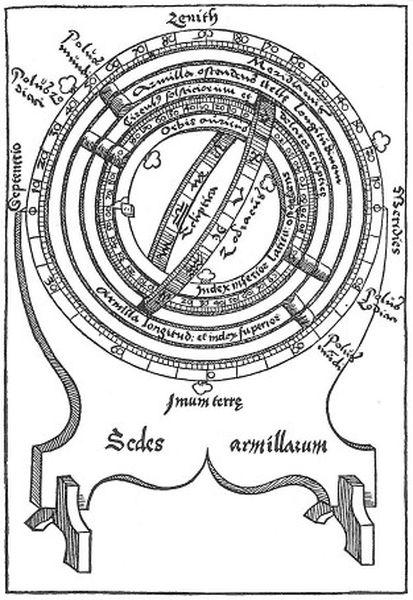While constructing his system of the world and then presenting it in De revolutionibus Copernicus made use of observations of ancient astronomers and those conducted by himself. He did that in the manner developed by Ptolemy: observational material was limited to the essential minimum required to calculate the parameters of planetary models.
No wonder that the basic instruments used by Copernicus, descriptions of which may be found in De revolutionibus, were copies of the ones presented in the Almagest by Ptolemy. These were: solar quadrant, used for measurement of inclination of the ecliptic in relation to the celestial equator; armillary astrolabe - the most complex instrument used in astronomy of that time, with the use of which ecliptic latitude and longitude of stars and planets could be established; parallactic instrument, with the use of which the zenith distance of a celestial body could be determined, and which was used to determine the parallax of the Moon.
These instruments used by Copernicus were probably made of wood (although in the case of the quadrant Copernicus suggested stone and metal) and portable, placed on a floor laid in the horizontal plane and leveled as carefully as possible by means of a hydroscope or water level, lest it sag in any direction (translated by Edward Rosen). None of these instruments has survived, though we know that the parallactic instrument still existed in 1584, for it was then given by Johannes Hanov, a canon from Warmia, to Elias Olsen Morsing, Tycho Brahes co-worker, who at that time visited Frombork. The device was taken to Uraniborg obsevatory on the isle of Hven, and Brahe, who was very happy because of that, even composed a poem in honour of Copernicus instrument. It is worth noting that when in 1472–1504 Bernard Walther of Nuremberg conducted one of the most interesting observational programmes of the time he used parallactic instrument and an armillary astrolabe of the same kind as Copernicus.
The only surviving instrument of Copernicus may be seen in the porch of the castle in Olsztyn. It is a table charted on a vertical wall, presumably using the method of gnomonic projection, which would allow the determination of moments of equinox, and track solar motion along the ecliptic in the vicinity of the equinoxes. In all probability, Copernicus made this table during his several years stay in Olsztyn, which began in 1516.
It is also known that to determine the maximum phase of partial solar eclipses between 1530 and 1541 Copernicus used camera obscura. The evidence of this may be found in systematic errors in the observations written down by the astronomer on pages of the Calendarium Romanum magnum by Johann Stoeffler, which was found in the library belonging to Copernicus. Unfortunately, Copernicus did not leave any explicit description of the method used. However, such description, probably transmitted by Rheticus, who stayed in Frombork on and off from 1539 to 1541, could be found in Erasmus Reinholds commentary to Peurbachs work Theoricae novae planetarum. Reinhold explains:
When calculations indicate an approaching solar eclipse, climb to the attic of a tall building or to a not-too-lowly chamber or to a room on an upper-floor, the higher the better for the task. Your observation post should be, as far as possible, devoid of all light. Yet even if you close every opening and block every crack, the solar rays will surely find a fissure or hole of whatever shape through which to penetrate into the room. Failing that, make yourself a small opening for the rays. This done, you will notice that the spot of sunlight on the floor or on the brick wall opposite the opening, most amazingly, takes the shape of the Sun, its face partly obscured by the Moon entering our field of vision. You can thus see with your own eyes what proportion of the 12 digits of the Suns luminous face has been concealed even if you watch the earth, rather than the sky. Such an ephemeral image will allow an apt observer to understand much more, make better estimates etc.
Videos
Further reading
- Britton, Ptolemys Determination of the Obliquity of the Ecliptic, "Centaurus", Vol. 14 (1969), 29–41.
- Dobrzycki, The Role of Observations in the Work of Copernicus, "Vistas in Astronomy", Vol. 17 (1975), 27–30.
- L. Kremer, Walthers Solar Observations: A Reply to R. R. Newton, "The Quarterly Journal of the Royal Astronomical Society", Vol. 24 (1983), 36–47.
- Włodarczyk, Observing with the Armillary Astrolabe, "Journal for the History of Astronomy", Vol. 18 (1987), 173–195.
- Włodarczyk, Solar Eclipse Observations in the Time of Copernicus: Tradition or Novelty?, "Journal for the History of Astronomy", Vol. 38 (2007), 351–364.
 English (United Kingdom)
English (United Kingdom)  Polski (PL)
Polski (PL) 







